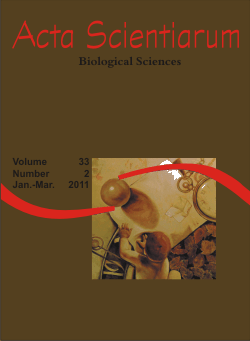<b>Longitudinal variation of attributes from flagellate protozoan community in tropical streams</b> - doi: 10.4025/actascibiolsci.v33i2.7228
Resumo
This study verified the existence of longitudinal patterns in species composition, richness, density and biomass of flagellate protozoan in tropical streams and investigated whether the possible zonation patterns are different between two periods of the year. For this, samplings were carried out in three regions from 10 streams, during the summer and winter. The flagellate community may be considered species-rich, because it was represented by 106 taxa, belonging to 8 orders and 1 residual group. The values of density and biomass are greater than those commonly found in other lotic environments, with mean values close to 2.3x104 cels. mL-1 and 150.8 µgC L-1. We did not observe any conspicuous and significant longitudinal pattern of the attributes from flagellates community. Only temporal variations of these attributes were verified. The Pearson Correlation evidenced that this temporal patterns was mainly driven by the nutrients availability, temperature and dissolved oxygen, since, the higher values of species richness, density and biomass were recorded during the winter, when the higher concentrations of nutrients and dissolved oxygen and lower temperatures were registered. In summary, the absence of patterns may be ascribed to the unidirectional and continuous flow from lotic environments.Downloads
DECLARAÇÃO DE ORIGINALIDADE E DIREITOS AUTORAIS
Declaro que o presente artigo é original, não tendo sido submetido à publicação em qualquer outro periódico nacional ou internacional, quer seja em parte ou em sua totalidade.
Os direitos autorais pertencem exclusivamente aos autores. Os direitos de licenciamento utilizados pelo periódico é a licença Creative Commons Attribution 4.0 (CC BY 4.0): são permitidos o compartilhamento (cópia e distribuição do material em qualqer meio ou formato) e adaptação (remix, transformação e criação de material a partir do conteúdo assim licenciado para quaisquer fins, inclusive comerciais.
Recomenda-se a leitura desse link para maiores informações sobre o tema: fornecimento de créditos e referências de forma correta, entre outros detalhes cruciais para uso adequado do material licenciado.












1.png)




3.png)













